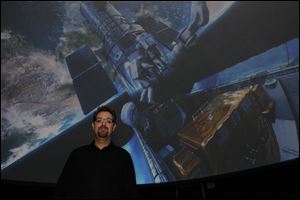
Images go out of this world
Ritter Planetarium buys $300,000 video system
10/18/2011
Ritter Planetarium Director Michael Cushing shows the Spitz SciDome video system that can project movies hemispherically on the domed ceiling of the facility on the University of Toledo campus.
Special effects of a high order are needed to impress moviegoers in today’s technological world, and the Ritter Planetarium at the University of Toledo thinks it has just the trick.
Planetarium officials on Monday showed the press its brand-new Spitz SciDome video system that can project movies hemispherically on the domed ceiling of the facility on the UT Main Campus.
Showtime included trailers for a couple of science movies in the SciDome format, views of the night sky over Toledo and sunrise over the university, and a journey into the Orion Nebula.
To a viewer, the 3-D images (no glasses needed) are spectacular, seeming to jump right out of the curvature of the overhead screen. Ritter officials describe the experience as “immersive.”
The $300,000 SciDome system replaces a slide projector that dated to 1967. Associate Professor of Astronomy Rupali Chandar said the old system made for ho-hum viewing by today’s standards.
“Kids today, quite frankly, have more power in their Xboxes and hand-held devices than that slide system had,” she explained.
Images from the SciDome projector have more than twice the resolution of high-definition television. The projector’s installation is part of a $350,000 renovation project at the planetarium that included replacement of its 92 seats, new carpeting, and fresh paint. The the building’s exterior also was refurbished.
Ritter Director Michael Cushing noted that the planetarium was able to screen movies before, but only on a small area of the 40-foot dome.
“Our goal moving forward is not only to make Ritter a cutting-edge tool for astronomy, but a cutting-edge tool for the university,” said Mr. Cushing, an assistant professor of astronomy.
Professor Chandar said she wanted Ritter to continue to be a popular destination for high school and grade-school classes.
“We’ll be open for school shows. We hope lots of kids come through and are wowed by the new technology,” she said.
Professor Cushing said Ritter was used by UT students in astronomy and other courses, but most of the students coming through the doors are in kindergarten through 12th grades.
“Our whole mission is to educate,” he explained.
The Ritter plans a grand reopening for Oct. 29 that will be free.
It will screen Black Holes: The Other Side of Infinity, a science movie narrated by Liam Neeson. The four free showings will be at 2, 4, 6, and 8 p.m.
Admission for future shows will be $6 for adults and $5 for children. Future show schedules will be posted at utoledo.edu/nsm/rpbo.
Contact Carl Ryan at: carlryan@theblade.com or 419-724-6095.